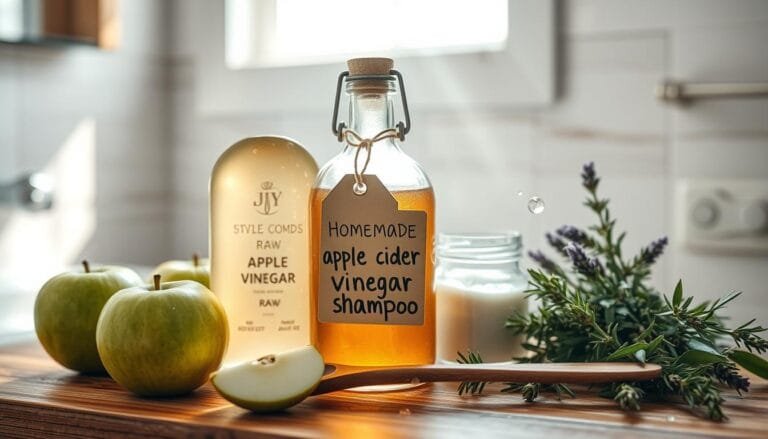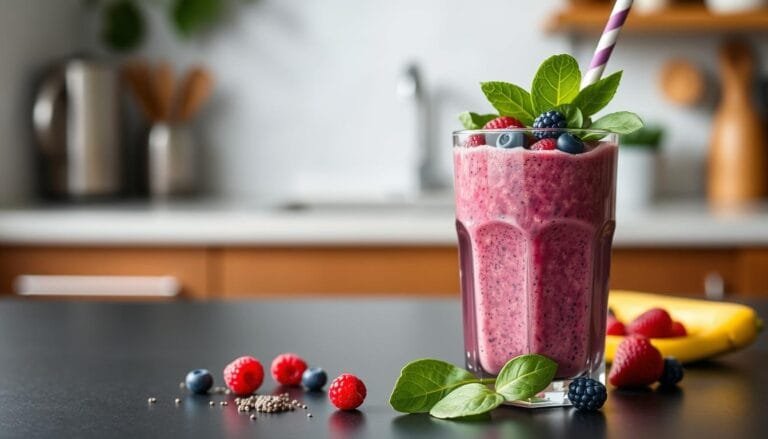Getting a bright smile doesn’t have to cost a lot. I found a natural teeth whitener – baking soda, or sodium bicarbonate. It’s been around for ages to fight stains and make teeth look better. I always use ARM & HAMMER™ Baking Soda for this.
Baking soda is gentle and removes stains from teeth. It also keeps my mouth’s acid levels in check, protecting my teeth. With a few easy steps, I can brighten my smile naturally.
Baking soda is my go-to for keeping my smile bright and tackling tough stains. Next, I’ll explain how it works and show you how to use it for a dazzling smile.
Understanding the Science Behind Baking Soda for Teeth
Baking soda, or sodium bicarbonate, is a natural way to keep your teeth healthy and bright. It’s an alkaline compound that fights tooth discoloration and decay. Let’s explore how baking soda helps your teeth.
How Alkalinity Affects Tooth Stains
The pH balance in your mouth is key to dental health. Baking soda’s alkaline nature fights acidity that can lead to tooth decay. It makes your mouth’s pH more balanced, stopping bacteria that cause cavities.
This alkaline property also breaks down stains from food and drinks, making your teeth whiter.
The Abrasive Properties of Sodium Bicarbonate
Baking soda also has a mild abrasive quality. This quality gently polishes your tooth enamel, removing stains and plaque without harming your enamel. Research shows baking soda toothpaste is better at removing plaque than non-baking soda toothpaste.
But, using too much baking soda can wear down your enamel. It’s important to use it in moderation and correctly in your oral care routine.
“Baking soda is a more affordable alternative to commercial teeth whitening products, with studies demonstrating its effectiveness in removing stains and plaque.”
Benefits of Using Natural Teeth Whitening Methods
Looking for a safe and effective way to brighten your smile? Natural teeth whitening methods like baking soda are perfect. Baking soda, or sodium bicarbonate, is easy to find and has many uses. It’s great for whitening teeth without harsh chemicals.
Baking soda is also an antiseptic. It fights bacteria, prevents tooth decay, and helps with oral diseases. This makes it good for your overall mouth health, not just whitening. It also neutralizes acids, protecting your teeth and gums.
Natural whitening methods are also budget-friendly. Baking soda is much cheaper than store-bought or professional whitening. It’s easy to add to your daily routine, making it a smart choice for a healthy smile.
Baking soda is gentle but effective. It removes stains without harming your enamel. This is safer for those who are sensitive or get irritated from harsh products.
In short, natural teeth whitening with baking soda has many benefits. It’s chemical-free, affordable, and easy to find. By using baking soda daily, you can get a beautiful smile without the risks or costs of commercial products.
| Benefit | Explanation |
|---|---|
| Chemical-free whitening | Baking soda is a natural, gentle abrasive that effectively removes surface stains without harsh chemicals. |
| Cost-effective | Baking soda is an inexpensive, readily available ingredient that can be easily incorporated into your daily oral care routine. |
| Antiseptic properties | Baking soda has the ability to reduce bacteria in the mouth, combat tooth decay, and fight other oral diseases. |
| Versatile for oral care | Baking soda can be used for a variety of oral health purposes, including whitening, plaque removal, and freshening breath. |
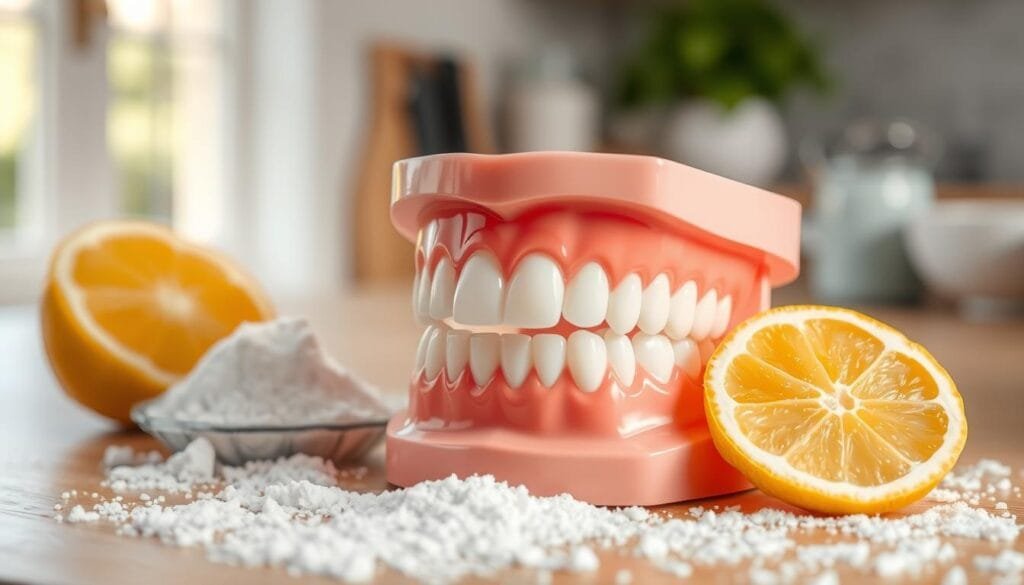
“Baking soda is a safe, natural, and cost-effective way to achieve a brighter, healthier smile.”
Baking Soda Teeth Whitener: Step-by-Step Application Guide
Want a brighter smile? Look in your kitchen pantry for baking soda. It’s a natural way to whiten your teeth. Making the right paste and applying it correctly can make your smile shine.
Creating the Perfect Baking Soda Paste
Mix one tablespoon of ARM & HAMMER™ Baking Soda with an equal amount of water. Stir until it’s smooth and creamy. The paste should be thick and easy to spread on your teeth.
Proper Application Techniques
- Use a soft-bristled toothbrush or clean fingers to apply the paste.
- Brush in gentle, circular motions for about 2 minutes.
- Don’t scrub too hard to avoid damaging your enamel.
- Rinse well with water or mouthwash after brushing.
Recommended Treatment Duration
Use this paste 2-3 times a week for the best results. Regular use will remove stains and brighten your smile. But, don’t use it more than twice a week to avoid sensitivity or enamel damage.
Follow these steps to whiten your teeth naturally at home. Always talk to your dentist before trying new whitening methods.
Safety Considerations and Enamel Protection
Using baking soda for teeth whitening needs careful thought. It’s cheap and easy to find, but it can harm your teeth if not used right. It might cause enamel erosion and tooth sensitivity.
For safe whitening, use a soft-bristled toothbrush and gentle brushing. Don’t scrub too hard or for too long. This can hurt your enamel and teeth.
Always talk to a dentist before whitening your teeth. They can help choose the best method for you. This might be baking soda or something else.
“The Australian Dental Association advises caution when using home remedies like baking soda for teeth whitening due to enamel and gum damage.”
Be careful not to overdo it with baking soda. Too much or wrong use can harm your teeth. Listen to your dentist and brush gently for a brighter smile.
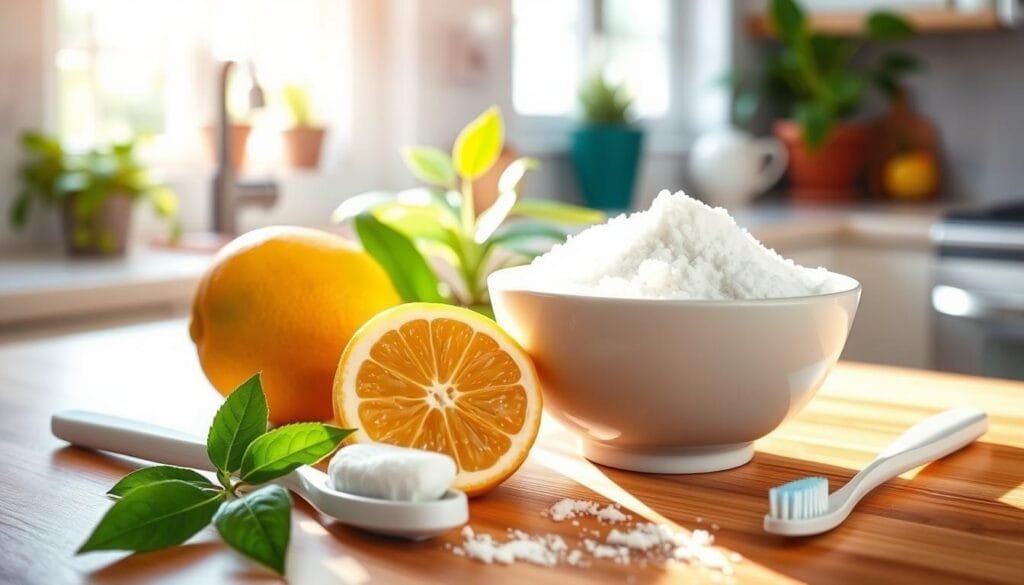
Combining Baking Soda with Hydrogen Peroxide
For a stronger whitening effect, mix baking soda with hydrogen peroxide. This duo boosts stain removal and oxidation. It makes your teeth brighter and whiter. The trick is to find the right mix and how to apply it to get the best results without harm.
Mixing Ratios and Instructions
To make a whitening paste, mix 1 tablespoon of baking soda with 2 tablespoons of 3% hydrogen peroxide. Stir until it’s smooth and creamy. Then, apply it to your teeth for up to a minute before rinsing well.
Enhanced Whitening Effects
Using baking soda and hydrogen peroxide together can whiten teeth better than baking soda alone. The peroxide whitening breaks down stains, and the enhanced stain removal of baking soda makes your smile brighter. This oxidation process is great for removing tough stains and yellowing.
Remember, this method can work well, but use caution. Too much hydrogen peroxide can cause tooth sensitivity and other problems.
“Baking soda and hydrogen peroxide are a powerful combination for whitening teeth at home. Just be sure to use them as directed and monitor for any sensitivity or other issues.”
How Often Should You Use Baking Soda for Whitening
Baking soda is a good, cheap way to whiten teeth. But, it’s key to use it carefully to avoid harming your enamel. Experts say to use it no more than twice a week.
Using baking soda 2 to 6 weeks can lead to noticeable whitening. The whitening can last up to 48 hours after each use. For daily care, use a toothpaste with baking soda and fluoride. It whitens gently and fights cavities and strengthens teeth.
Even though baking soda is mild, using it too much can harm your enamel. To keep your smile safe, limit baking soda whitening to a couple of times a week. Always brush with a fluoride toothpaste every day.
| Frequency of Use | Whitening Effects | Enamel Protection |
|---|---|---|
| Twice a week | Gradual whitening over 2-6 weeks, lasting up to 48 hours | Minimizes risk of enamel damage |
| Daily use | Faster whitening results, but may not be sustainable | Higher risk of enamel wear and sensitivity |
| Toothpaste with baking soda | Gentle, gradual whitening benefits | Helps maintain oral health and enamel integrity |
By using baking soda wisely, you can get a brighter smile. This way, you also keep your teeth healthy for the long term.
“Baking soda is a gentle, yet effective way to gradually whiten teeth, as long as it’s used responsibly and in moderation.”
Comparing Store-Bought vs. DIY Whitening Solutions
There are many ways to get a whiter smile, from store-bought products to dental treatments. DIY baking soda whitening is cheap but might not work as well as products with hydrogen peroxide.
Store-bought whiteners have about 10% active ingredients. But, dental treatments can have up to 40%. This means dental treatments can make your smile up to eight shades brighter in just 90 minutes.
Cost Analysis
Store-bought whiteners cost between $4 and $100. Dentist-dispensed products are about $400. In-office whitening can cost $650 per session. But, professional treatments might be worth it for lasting results.
Effectiveness Comparison
Baking soda can remove surface stains but might not be as strong as commercial products. Crest Whitestrips Supreme, with 14% hydrogen peroxide, costs around $50 for three weeks. Professional treatments are made for your specific needs.
Choosing between store-bought and professional whitening depends on your budget and what you want. Talking to a dentist can help you decide and keep your teeth and gums healthy.
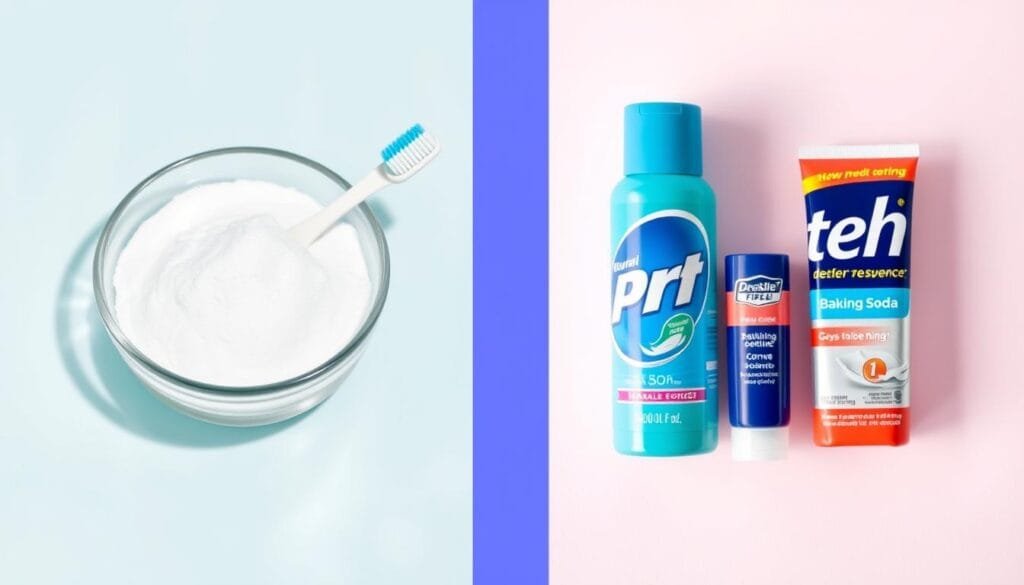
Common Mistakes to Avoid When Whitening with Baking Soda
Using baking soda to whiten your teeth can be a smart and affordable choice. But, it’s important to watch out for mistakes that can harm your teeth. Let’s look at these errors and how to avoid them safely.
One big mistake is overusing baking soda. It can remove stains but too much can damage your enamel. Try to use it only a few times a week, as suggested.
Another error is aggressive brushing. Brushing too hard can wear down your enamel. Use a soft, circular motion to clean your teeth gently.
Don’t leave the baking soda paste on your teeth for too long. It can erode your enamel and cause irritation. Rinse well after a few minutes to remove all the paste.
Lastly, improper rinsing can ruin your whitening efforts. Not rinsing off all the paste can expose your teeth to more abrasion. Always rinse with water or a gentle mouthwash after using baking soda.
By avoiding these mistakes and following the right steps, you can safely brighten your smile with baking soda. Always talk to a dentist for the best advice on using baking soda for your teeth.
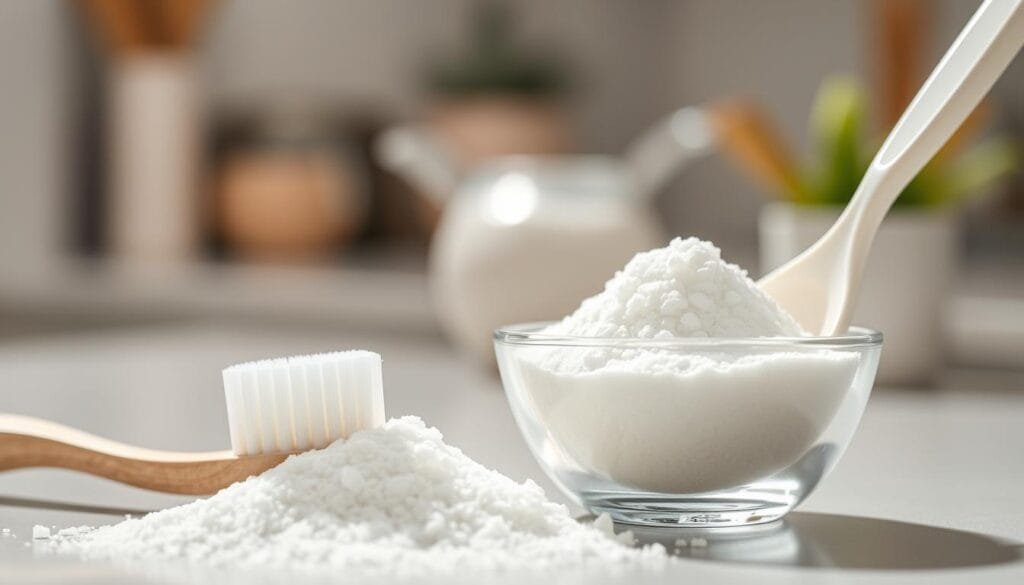
“Achieving a brighter, whiter smile through natural remedies like baking soda can be an effective and budget-friendly approach, but it’s important to be mindful of the common mistakes that can undermine your efforts and potentially damage your teeth.”
Alternative Natural Whitening Methods
Baking soda is a great and cheap way to whiten teeth naturally. But, there are other methods too. Oil pulling and activated charcoal can brighten your smile without harsh chemicals.
Oil Pulling with Coconut Oil
Oil pulling uses coconut oil to clean your mouth. It’s been around for centuries. It can cut down on plaque and bad breath. It might even whiten your teeth over time. Do it for 15-20 minutes a day for the best results.
Brushing with Activated Charcoal
Activated charcoal removes stains from your teeth. Wet your toothbrush, dip it in charcoal powder, and brush for a few minutes. Rinse well. But, don’t use too much charcoal to avoid harming your enamel.
Strawberry Paste
Strawberries have malic acid, a gentle whitener. Mash strawberries into a paste and apply to your teeth. Let it sit for 5 minutes before rinsing. The acid breaks down stains, and vitamin C is good for your gums.
Apple Cider Vinegar Rinse
Apple cider vinegar can whiten your teeth when diluted. Mix 1 part vinegar with 8 parts water. Swish it in your mouth for 30 seconds and then rinse. But, be careful as it can wear down enamel if used too often.
These natural whitening methods can work well if used right. Always talk to your dentist before adding them to your routine. The right amount and technique are key to a brighter smile without harm.
“Maintaining good oral hygiene and using natural whitening agents in moderation can help you achieve a brighter, more confident smile.” – Dr. Sarah Howe, Cosmetic Dentist
Professional Dental Insights on Baking Soda Use
I’ve always been curious about using baking soda for teeth whitening. I looked into what experts and research say about this natural ingredient.
Expert Recommendations
The American Dental Association (ADA) says baking soda is safe and works well in toothpaste. It’s also in some professional whitening products because it removes stains.
But, some dentists say baking soda might not get rid of deep stains or make teeth very white. They suggest using ADA-approved toothpaste or seeing a dentist for tough stains.
Clinical Studies and Research
Studies in The Journal of the American Dental Association show baking soda can remove stains and whiten teeth. It does this by gently removing surface stains, making teeth look brighter.
Yet, research finds baking soda might not be as strong as other whitening agents. Using too much could harm tooth enamel. So, experts advise using it carefully and in small amounts.
Dental experts agree baking soda can help keep teeth healthy and brighten them. But, it should be part of a routine that includes ADA-approved products. Always talk to your dentist to find the best care for your teeth.
Long-term Effects and Maintenance
To keep your smile bright, mix baking soda treatments with good oral care. Brush with fluoride toothpaste, floss, and avoid staining foods like red wine and coffee. Baking soda helps keep your teeth white, but don’t forget to protect your enamel.
Seeing your dentist regularly is vital. They can check your teeth and ensure your whitening works. Baking soda is cheap and easy to use, but talk to your dentist first to avoid harm.
Good oral hygiene and baking soda treatments can give you a long-lasting, healthy smile. Just remember to use baking soda carefully and prevent stains to protect your teeth.

